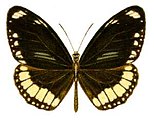Euploea sylvester
| Double-branded crow | |
|---|---|

| |
| Scientific classification | |
| Domain: | Eukaryota |
| Kingdom: | Animalia |
| Phylum: | Arthropoda |
| Class: | Insecta |
| Order: | Lepidoptera |
| Family: | Nymphalidae |
| Genus: | Euploea |
| Species: | E. sylvester
|
| Binomial name | |
| Euploea sylvester (Fabricius, 1793)
| |
| Synonyms | |
Euploea sylvester, the double-branded crow,[2] also known as the two-brand crow[1] in Australia, is a butterfly found in South Asia,[2] Southeast Asia and parts of Australia that belongs to the crows and tigers, that is, the danaid group of the brush-footed butterflies family.[1]
Several races of the butterfly are recognized. Race pelor is found in Australia.[3]
Subspecies[edit]
The subspecies of Euploea sylvester are-[1][2]
- E. s. sylvester - Cape York - Rockhampton, Torres Strait Is.
- E. s. coreta (Godart, 1819) - Sri Lanka, S.India
- E. s. hopei (Felder & Felder, 1865) - Sikkim - Burma, Assam, Indo-China, Peninsular Malaya
- E. s. swinhoei - Taiwan
- E. s. pelor Doubleday, 1847 - NW.Australia, Northern Territory
Description[edit]

In shape, colour, and markings, it very closely resembles Euploea core. Males, however, can be distinguished at once by the presence of two brands instead of a single one on the forewing. Of the females Lionel de Nicéville says, females of E. coreta can be separated from the females of E. core by the following points: "First by the outline of the forewing being more entire; in core it is slightly but perceptibly scalloped- Second, by the underside of the forewing having a complete series of six spots, one between each pair of nervules outside the cell; in core two of these spots, those above the discoidal nervules (veins 5 and 6), are always wanting. Third, the two brands on the interno-median area (interspace 1) of the forewing in the male are faintly but quite perceptibly to be traced in the female in the same position."[4][5]
Larval food plants[edit]
The double-banded crow feeds on plants of the families Apocynaceae (dogbanes and oleanders) including Parsonsia, Hoya, and Cynanchum,[6] Asclepiadaceae (milkweeds) including Marsdenia[7] and Moraceae (figs) including Ficus obliqua, Ficus microcarpa, Ficus racemosa, Gymnema sylvestre and Ichnocarpus frutescens [8]
Gallery[edit]
-
Euploea sylvester pelor In Australia
-
Euploea sylvester hopei In Buxa Tiger Reserve, West Bengal, India
-
Euploea sylvester coreta In Bangalore, Karnataka, India
See also[edit]
References[edit]
- ^ a b c d e Savela, Markku. "Euploea sylvester (Fabricius, 1793)". Lepidoptera and Some Other Life Forms. Retrieved July 1, 2018.
- ^ a b c Varshney, R.K.; Smetacek, Peter (2015). A Synoptic Catalogue of the Butterflies of India. New Delhi: Butterfly Research Centre, Bhimtal & Indinov Publishing, New Delhi. p. 152. doi:10.13140/RG.2.1.3966.2164. ISBN 978-81-929826-4-9.
- ^ Meyer, C.E. (1997) Notes on the life history and variation in adult forms of Euploea sylvester pelor Doubleday (Lepidoptera: Nymphalidae: Danainae), The Australian Entomologist. 24(2):73-77.
- ^
 One or more of the preceding sentences incorporates text from this source, which is in the public domain: Bingham, Charles Thomas (1907). Fauna of British India. Butterflies Vol. 2. Taylor & Francis. pp. 29–11.
One or more of the preceding sentences incorporates text from this source, which is in the public domain: Bingham, Charles Thomas (1907). Fauna of British India. Butterflies Vol. 2. Taylor & Francis. pp. 29–11.
- ^
 One or more of the preceding sentences incorporates text from this source, which is in the public domain: Moore, Frederic (1890–1892). Lepidoptera Indica. Vol. I. London: Lovell Reeve and Co. p. 134.
One or more of the preceding sentences incorporates text from this source, which is in the public domain: Moore, Frederic (1890–1892). Lepidoptera Indica. Vol. I. London: Lovell Reeve and Co. p. 134.
- ^ Vane-Wright, R.I, & de Jong, R. (2003). The butterflies of Sulawesi: annotated checklist for a critical island fauna. Zoologische Verhandelingen, 343, 3–267 https://repository.naturalis.nl/pub/220217/
- ^ Vane-Wright, R.I, & de Jong, R. (2003). The butterflies of Sulawesi: annotated checklist for a critical island fauna. Zoologische Verhandelingen, 343, 3–267 https://repository.naturalis.nl/pub/220217/
- ^ HOSTS - a Database of the World's Lepidopteran Hostplants (http://www.nhm.ac.uk/research-curation/projects/hostplants/) accessed on September 12, 2007.



